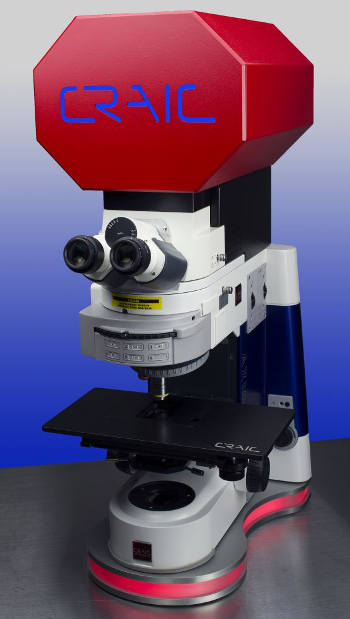CRAIC Technologies, the world leading innovator of microspectroscopy solutions, takes optical information acquisition a step further with photoluminescence (PL).

Users of the 20/30 PV™ microspectrophotometer, and other CRAIC Technologies' models, have the ability to acquire photoluminescence spectra and images of microscopic sample areas throughout the UV, visible and NIR regions. Additionally, the 20/30 PV™ can be used to monitor the time dependences of these spectra using CRAIC Technologies' kinetic software TimePro™ or map large scale objects with microscopic spatial resolution.
Upon a molecule's absorption of a photon of a particular wavelength or energy, the molecule promotes an electron from the ground state to an excited state. The excited state in most molecules is labeled as a singlet state. These types of states can re-emit a photon quickly, producing fluorescence. In addition to emitting quickly, fluorescence also has a short lifetime. In other words, the emitted light lasts only a short time and only gives information about that particular singlet state.
However, singlet states are not the only accessible electronic states and excited molecules can undergo a phenomenon called intersystem crossing, where the excited electron is transferred to a state of higher multiplicity than a singlet; for example a triplet. Triplet states also emit photons (of different wavelengths than singlet states) and these emissions occur for much longer time periods, on the order of milliseconds to minutes and even hours (think glow in the dark!). This type of emission is often referred to as phosphorescence.
Photoluminescence encompasses fluorescence, phosphorescence, and any type of photon emission that a molecule or sample exhibits. The key here is that the emission does not have to be optically stimulated itself. This exciting and informative type of emission occurs in a wide range of molecule types: from engineered materials to biological to devices! And CRAIC Technologies' instruments provide numerous solutions to study the PL of samples on the micro scale, down to a single square micron, and of large-scale samples but with extremely high spatial resolution.
“As more products and devices utilize ever smaller photoluminescent (PL) light sources in ever more demanding environments, the ability to test those devices with ultra-high spatial resolution and fidelity becomes increasingly important” states Dr. Paul Martin, President of CRAIC Technologies. “CRAIC Technologies microspectrometers are ideally suited for both research and quality control of such devices. Microspectrometers can quickly characterize and qualify PL devices allowing for researchers and manufacturers to develop ever better light sources.”
For more information about the 20/30 Perfect Vision™ microspectrophotometer, and other microspectrometers capable of photoluminescence microspectroscopy, visit www.microspectra.com.
About CRAIC Technologies
CRAIC Technologies, Inc. is a global technology leader focused on innovations for microscopy and microspectroscopy in the ultraviolet, visible and near-infrared regions. CRAIC Technologies creates cutting-edge solutions, with the very best in customer support, by listening to our customers and implementing solutions that integrate operational excellence and technology expertise. CRAIC Technologies provides answers for customers in forensic sciences, biotechnology, semiconductor, geology, nanotechnology and materials science markets who demand quality, accuracy, precision, speed and the best in customer support.